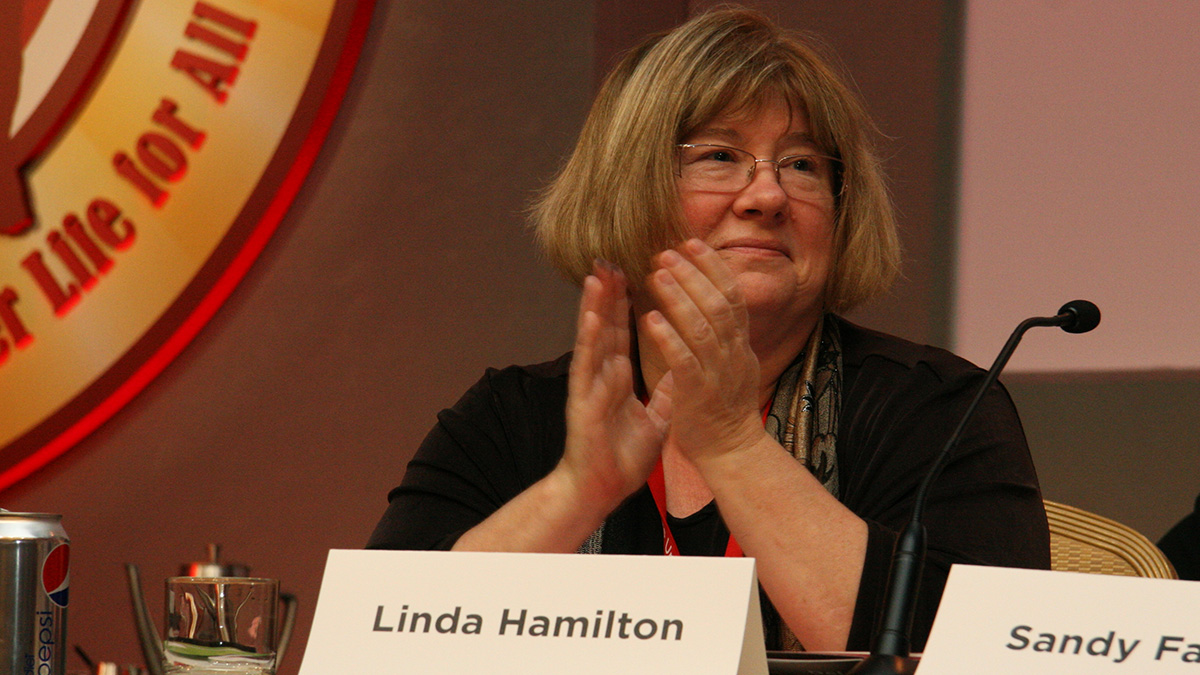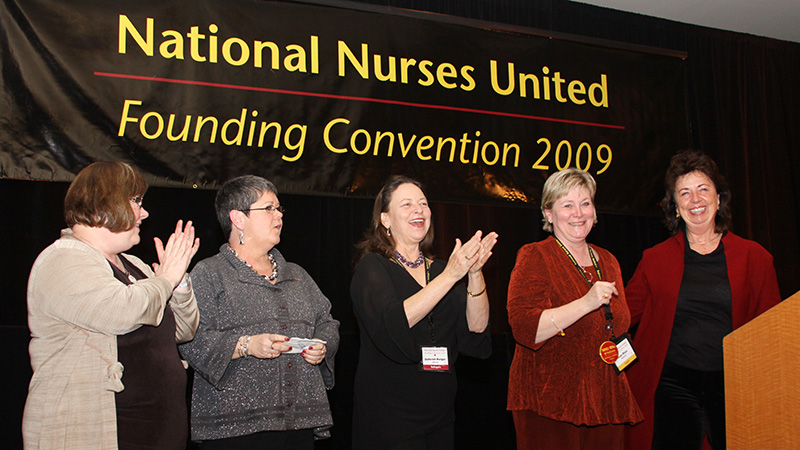Visionary Leader

NNU would not exist without Linda Hamilton
By Chuleenan Svetvilas
National Nurse magazine - July | August | September 2025 Issue
National Nurses United would not exist if it weren’t for Linda Hamilton. Hamilton and Jean Ross, RN and former president of National Nurses United (2009-2023), were part of the quorum of directors of an organization of progressive nursing unions that voted to support joining NNU in 2009. “A last-minute meeting had been called, and Linda was getting her hair done,” recalled Ross. “She got on the phone with her hair dripping wet, so we had a majority, which helped form NNU.”
Hamilton, who passed away at home in Lake Spring Park, Minn., in July 2025, was a registered nurse, fierce union leader, and committed health care activist with endless energy for fighting the good fight and enjoying life to its fullest. She had served in several union positions, including president of Minnesota Nurses Association (MNA), a director of United American Nurses (UAN), and a vice president of NNU. Her death was from pancreatic cancer.
“Nurses trusted Linda. It was a no-brainer that she would be our representative for United American Nurses and then a vice president for NNU,” said Ross, who met Hamilton about 30 years ago at an MNA rep meeting. “She had a strong sense of justice and was very, very generous with her time. She was extremely reliable. You don’t come across people like Linda in life.”
Deeply dedicated to her pediatric patients and the nursing profession, Hamilton mentored countless RNs and advocated for nurses on all fronts, from collective bargaining contracts and nursing practice to the state capital and beyond. “She encouraged me to grow in the union and run for office,” said Bernadine “Bunny” Engledorf, RN, former NNU vice president, and MNA board member. “Linda helped me realize that I could do that.”
Hamilton was a visionary who saw the value of a national union: Together with Ross, UAN’s secretary-treasurer from 2006 to 2009, and two other UAN directors — Carolyn Hietamaki, RN of Michigan Nurses Association and Sandra Falwell, RN of District of Columbia Nurses Association, this quartet of nurses ensured that UAN would be part of NNU’s founding convention in Phoenix. In December 2009, direct-care nurses from California Nurses Association/National Nurses Organizing Committee (CNA/NNOC), UAN, and others created a historic national RN super-union with more than 150,000 nurses across the country. NNU now has more than 225,000 members nationwide. Hamilton was not only a founding member of NNU, she served on its board for nearly a decade.
UAN was the American Nurses Association’s labor wing, which formed in 1999 and comprised several state nurses associations, several of which broke away from ANA, including Maine State Nurses Association (MSNA) in 2001 and Michigan Nurses Association and Minnesota Nurses Association in 2008. California Nurses Association cut ties with ANA in 1995 and formed National Nurses Organizing Committee in 2005 in response to an overwhelming demand by direct-care nurses outside of California. MSNA joined NNOC in 2006.
“It was Linda’s calling in life to be a nurse and a union leader,” said Engledorf. “She was involved in the growth and development of MNA as a true union for registered nurses. Linda, Jean, and I helped orchestrate the house of delegates to leave ANA and become a stronger union.”
Hamilton’s active involvement in MNA began in the 1990s when she was working at Children’s Minnesota in Minneapolis. She had been given a verbal warning for a medical error that was not her fault. After her union steward accompanied her to a meeting with a manager, Hamilton filed a grievance and won, getting the warning removed from her file. When she learned that her hospital planned to return to a team nursing model, the steward asked Hamilton if she would like to be a steward because of her strong feelings against team nursing. She said yes, and soon stepped up to a leadership role at her facility after a chair quit and no one else was willing to take on the position.
Hamilton was always willing to do more for nurses, patients, and the profession. She advocated for no-fault reporting at her hospital in the early 2000s, an idea that took off after the Institute of Medicine issued its groundbreaking 1999 report “To Err is Human: Building a Safer Health System.” Hamilton saw errors as an opportunity to learn, reduce risks, and examine systemic issues that affect patient safety. “Near misses are never reported because they’re not viewed as an error,” said Hamilton in a 2006 interview. “There were accidents waiting to happen, and no mechanisms to report them.”
By the early 2000s, she became MNA’s metro chair and chair of the union’s Economics and General Welfare Commission. She also served as a director of UAN from 2006 to 2009. Meanwhile, in 2007 she was elected MNA treasurer and in 2009, a pivotal year for RN unions, Hamilton was elected MNA president, serving until 2015, and became a vice president of NNU. She took on increasing responsibilities with the staunch support of her husband Tom Hamilton. He said he was her personal assistant and confidant, doing everything from handling her scheduling and emails to anything else she needed help with. Dubbed the “First Dude” by MNA staff, everyone knew to contact him if they needed to get in touch with Hamilton. “I was very proud to be the man behind the woman,” said Tom Hamilton.
Hamilton was sworn in as MNA’s president when the union had only been disaffiliated from ANA for about a year. “Linda was both a stabilizing force and a progressive force,” said Ross of Hamilton’s legacy at MNA. “She was interested in making us a stronger trade union. At the time, there was still a core group of nurses who were afraid to be union. She helped lead us in the right direction.”
Less than a year after Hamilton was president, 12,000 MNA nurses across six hospital systems in the Twin Cities walked off the job in June 2010, holding the largest RN strike in history at the time. The nurses ratified a three-year contract the following month, averting a second strike.
“Linda was very adamant about growing the president’s role so that MNA could be effective at the capital and be known by legislators so that our voices meant something,” said Engeldorf.
Mary Turner, RN, and NNU president, heartily agrees. “Linda saw the importance of being involved politically,” said Turner, who was elected to MNA’s board of directors in 2012, the year she met Hamilton. “She was very involved in the AFL-CIO and the DFL party [Minnesota Democratic-Farmer-Labor].”
Hamilton volunteered in many political candidates’ campaigns over the years, including Barack Obama, Al Franken, Keith Ellison, and her son Shawn Hamilton, who ran for state representative in 2008. At an AFL-CIO national convention in 2009, she was recognized for her election volunteer work as a union activist and leader.

RN, and Rose Ann DeMoro.
Hamilton was also a tireless advocate for Medicare for All. She strongly believed that health care was a human right. “My mother instilled that in me and my brother,” said Cassie Snodgrass, Hamilton’s daughter and a labor and delivery nurse at Mercy Hospital in Coon Rapids, Minn. “Health care is not a privilege. It’s a right.”
“Linda took me under her wing because of the way I viewed the role as director,” said Turner, who also served as MNA’s president from 2015 to 2023. “My mentality was: I represent all the nurses now, not just the metro area.”
When Turner told Hamilton that she wanted to go up to bargaining units in northern Minnesota to support them, she got the MNA president’s wholehearted approval. In fact, Hamilton and Ross joined her on her first few road trips to that part of the state. “Linda was always very supportive of me,” said Turner. “She gave me every opportunity to be in front of nurses. She was a great teacher and a great mentor. I’m so grateful for the opportunity and for the vision that she saw in me as a leader. She helped give me the confidence to run for president of MNA.”
In 2011, Hamilton was recognized by the Saint Paul Regional Labor Federation (SPRLF) with its inaugural Labor Leader Award in “appreciation of tireless efforts and experienced leadership that has greatly benefitted the Saint Paul Regional Labor Federation.” As Bobby Kasper, SPRLF president at the time, noted, “The MNA made safe staffing a focus of their contract campaign two years ago, and they continue to fight for their members at the Capitol, where everybody knows the MNA means business! Linda Hamilton also understands the importance of unions working together ... That’s why she is a tireless advocate for the Saint Paul Regional Labor Federation.”
She carried that tenacity to winning Medicare for All. In 2024, as she was fighting pancreatic cancer, Hamilton shared her story about the challenges of getting appropriate pain medication and treatment because she wanted to raise more awareness about the difficulties of navigating a health care system that delays care and denies claims. Her experience confirmed her strong belief that “quality health care for all is a fight worth fighting for,” stating, “Over 30 years, I found my union was the best place for me to advocate for patients and my profession.”
And she continued to be an advocate until the very end. Her daughter Cassie Snodgrass said that her mother was someone who stood for standing strong and fighting for patients, the nursing profession, and social justice. She led by example, and her legacy lives on in the nurses she mentored and many people whose lives she touched. “She was always looking to the future,” said Snodgress. “Her approach was to learn from the past, learn from mistakes, but move forward.”
Chuleenan Svetvilas is a communications specialist at National Nurses United.